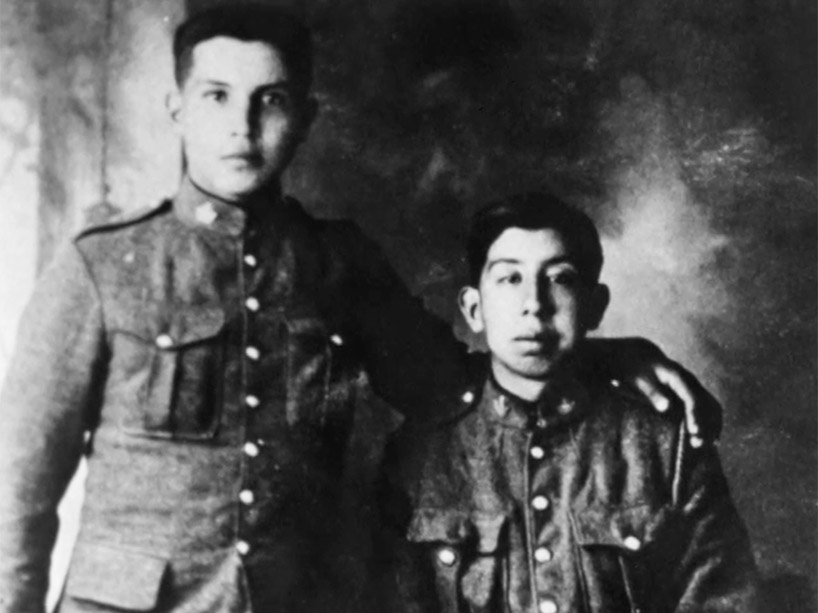Forgotten soldiers

An old photograph of two soldiers featured in the documentary Forgotten Warriors, produced by School of Creative Industries professor T’hohahoken Michael Doxtater.
Imagine having to sit in a tank, shooting at soldiers, as it makes its way across trench warfare. Picture German soldiers running off in defeat as Canadian forces emerge from their tanks victorious.
This is one of many stories School of Creative Industries professor T’hohahoken Michael Doxtater heard growing up, from family members who served during the First and Second World Wars.
“There is a history and tradition among Indigenous fighters that is so central and important to Canadian history,” says Doxtater “There wouldn't be a Canada today if it wasn’t for the Indigenous fighters at Queenston Heights and the Plains of Abraham. And that has been excluded and diverted from history.”
Every year on Remembrance Day, thousands gather in a moment of silence and gratitude for those who fought for our country. We hear timeless stories of Canadian soldiers who fought with bravery, the families they left behind to fight for freedom and the huge amount of respect they deserve now as veterans. What appears to be missing from the conversations is the recognition of many of our racialized community members, and in particular Indigenous men and women who served during the war.
Doxtater comes from a long line of fighters in his family: his grandfather and four great uncles fought during the First World War; and his father served in the Second World War.
“My Uncle Wes told a story about how it was Indigenous soldiers [who] were in the first tanks that went into battle,” Doxtater said. “And he said that what happened was they’d have these great big machines with treads up to the battlefield where there were trenches of German soldiers. And my Uncle Wes, with his gun shooting out of the side, going across the battlefield, going across the trenches .... when the Germans all ran off and disembarked from their tanks, then they told the Indians to go stand over there on the hill and then they put all the white guys in front of the tanks and took the pictures. Now, this is the oral tradition from people that were there. And I have no reason to suspect they would tell a story that wasn't true.”
School of Creative Industries professor T’hohahoken Michael Doxtater produced a documentary in 1997 called Forgotten Warriors (external link) about the thousands of Indigenous men and women who enlisted during the Second World War.
Forgotten warriors
During the First World War, it’s estimated that more than 4,000 Indigenous Peoples’ fought during the conflict in various units of warfare. Many voluntarily enlisted for different reasons: to seek employment, an opportunity to leave the reservation and to uphold the traditions of their ancestors who fought in previous battles.
Veteran Affairs Canada (external link) featured some of the Indigenous people who have served in many wars, including the Second World War, and Korean and Vietnam Wars. The website highlighted the valuable skills they brought to the military such as patience, stealth and marksmanship - “well-honed traits for those who had come from communities where hunting was a cornerstone of daily life. These attributes helped many of these soldiers become successful snipers (military sharpshooters) and reconnaissance scouts (men who stealthily gathered information on enemy positions).”
Their duties expanded in subsequent wars when Indigenous soldiers became code talkers, translating radio messages into Cree and then into English to avoid enemy interception. Women also played a role, both home and abroad, raising money on the homefront for the war effort, knitting socks and sweaters to be sent overseas and serving as nurses.
Although it’s been reported that Indigenous and non-Indigenous soldiers shared a common bond during the war, unfortunately that experience changed after the war. Indigenous veterans did not receive the same treatment as their non-Indigenous counterparts upon returning from war.
Individual communities celebrated their return with Sun Dances - a tradition that was outlawed by the federal government - but the Indian Act disenfranchised Indigenous Peoples who enlisted, restricting them from buying land off the reservation and forcing them to give up their status if they served. In 1994, the Government of Canada inaugurated Indigenous Veterans Day on November 8.
Warrior society
English professor Jennifer Meness (Waabishkaa Migizi, White Eagle) is Eagle Clan (Migizi Dodem) from the Algonquins of Pikwàkànàgan First Nation. Her father is a Vietnam vet who served as part of the U.S. Navy and her partner is a veteran of the Canadian Armed Forces. She explained that there are parallels between military service and warrior society in Indigenous culture.
“Warriors were responsible for protecting the community, so they hold a very significant place in our society,” said Meness, whose primary research is on powwows, and the community gathering and spirit that is celebrated at those traditions.
Meness says veterans have a special dance at powwows that is typically done after the Grand Entry and opening invocation.
“When warriors came back from battles, they would tell stories with dance and that's where a lot of men's traditional dance comes from, whether it's the war stories where they're sneaking up on an enemy, or they're sneaking up on game, it's that same sort of movement that tells the story,” Meness said.
“I feel such a sense of pride that my dad served and when I see him dance at powwow. My dad's regalia, he wears his Navy ribbons so his outfit looks very military. He wears the stripes from his uniform that he’s incorporated into his look. So I think being a warrior and being a veteran, that's a big sense of identity, they've been able to claim that warrior role.”





